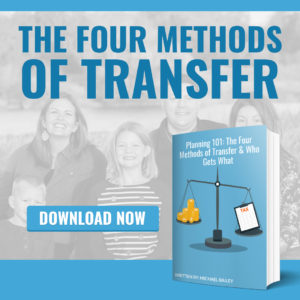
On December 20, 2019, the Setting Every Community Up for Retirement Enhancement Act (SECURE Act) changed the rules concerning retirement accounts. The SECURE Act became effective January 1, 2020. The Act is the most impactful legislation affecting retirement accounts in decades. The SECURE Act has several positive changes: It increases the required beginning date (RBD) for required minimum distributions (RMDs) from your individual retirement accounts from 70 ½ to 72 years of age, and it eliminates the age restriction for contributions to qualified retirement accounts. However, perhaps the most significant change will affect the beneficiaries of your retirement accounts: The SECURE Act requires most designated beneficiaries to withdraw the entire balance of an inherited retirement account within ten years of the account owner’s death. If a beneficiary is not considered a designated beneficiary, distributions must be taken within five years of the owner’s death. Common examples of beneficiaries that are not designated beneficiaries are charities and estates according to Treas. Reg. § 1.401(a)(9)-3, Q&A (4)(a)(2) and 1.401(a)(9)-5, Q&A (5)(b).
The SECURE Act does provide a few exceptions to this new mandatory ten-year withdrawal rule: spouses, beneficiaries who are not more than ten years younger than the account owner, the account owner’s children who have not reached the “age of majority,” disabled individuals, and chronically ill individuals. However, proper analysis of your estate planning goals and planning for your intended beneficiaries’ circumstances are necessary to ensure what you want to happen comes to fruition.
You may want to revisit your estate plan, and review your existing trust to see if changes need to be made. You may want to use a different type of trust, or add another trust just for your retirement accounts. You may want to meet with both your financial planner and your estate planner, to make sure your plan will work for what you want. You need to be proactive, or else you may be stuck under the new rules, but with old planning that might not work.
Under the old law, beneficiaries of inherited retirement accounts could take distributions over their individual life expectancy. Under the SECURE Act, the shorter ten-year time frame for taking distributions will result in the acceleration of income tax due, possibly causing your beneficiaries to be bumped into a higher income tax bracket, thus receiving less of the funds contained in the retirement account than you may have originally anticipated.
During the ten year payout, your beneficiaries will need to plan to take the payout, or reposition the assets into some other investment. Such repositioning can be done all at once, or over time, but if the retirement accounts pay out over ten years, then those ten years will be the only time available to reposition funds in retirement accounts. Those ten years may be high tax rate years for your beneficiaires, so it may be desirable to reposition retirement funds now, while tax rates are low, or while your tax rates may be low.
Your estate planning goals likely include more than just tax considerations. You might be concerned with protecting a beneficiary’s inheritance from their creditors, future lawsuits, and a divorcing spouse. In order to protect your hard-earned retirement account and the ones you love, it is critical to act now.
Contact Michael Bailey, Estate Planning Attorney ⬇️

Review/Amend Your Revocable Living Trust (RLT)
 Depending on the value of your retirement account, you may have addressed the distribution of your accounts in your RLT. Your trust may have included a “conduit” provision, and, under the old law, the trustee would only distribute required minimum distributions (RMDs) to the trust beneficiaries, allowing the continued “stretch” based upon their age and life expectancy. A conduit trust protected the account balance, and only RMDs–much smaller amounts–were vulnerable to creditors and divorcing spouses. With the SECURE Act’s passage, a conduit trust structure will no longer work to stretch out the payments over the beneficiary’s lifetime because the trustee will be required to distribute the entire account balance to a beneficiary within ten years of your death.
Depending on the value of your retirement account, you may have addressed the distribution of your accounts in your RLT. Your trust may have included a “conduit” provision, and, under the old law, the trustee would only distribute required minimum distributions (RMDs) to the trust beneficiaries, allowing the continued “stretch” based upon their age and life expectancy. A conduit trust protected the account balance, and only RMDs–much smaller amounts–were vulnerable to creditors and divorcing spouses. With the SECURE Act’s passage, a conduit trust structure will no longer work to stretch out the payments over the beneficiary’s lifetime because the trustee will be required to distribute the entire account balance to a beneficiary within ten years of your death.
As an alternative, you could consider the benefits of an “accumulation trust,” an alternative trust structure through which the trustee can take any required distributions and continue to hold them in a protected trust for your beneficiaries. Even with this type of “accumulation trust” the tax implications of a ten year payout will still need to be addressed. Trust tax rates can be higher than individual tax rates for the same amount of income, so evaluating your situation and how to minimize the tax impact of a payout to your trust, or your beneficiaries, is important to revisit in this new legal environment.
Consider Additional Trusts
 For most of you, a retirement account is one of the largest assets you will own when you pass away, usually rivaled only by your primary residence – your house. If you have not done so already, it may be beneficial to create a separate trust to handle your retirement accounts. While many accounts offer simple beneficiary designation forms that allow you to name an individual or charity to receive funds when you pass away, this form alone does not take into consideration your estate planning goals and the unique circumstances of your beneficiary. A trust is a great tool to address the mandatory ten-year withdrawal rule under the new Act, providing continued protection of a beneficiary’s inheritance, or continued control over how assets are used after you are gone. However, the 10 year period still will have tax consequences and without proper planning, your beneficiaries may lose significant money to taxes.
For most of you, a retirement account is one of the largest assets you will own when you pass away, usually rivaled only by your primary residence – your house. If you have not done so already, it may be beneficial to create a separate trust to handle your retirement accounts. While many accounts offer simple beneficiary designation forms that allow you to name an individual or charity to receive funds when you pass away, this form alone does not take into consideration your estate planning goals and the unique circumstances of your beneficiary. A trust is a great tool to address the mandatory ten-year withdrawal rule under the new Act, providing continued protection of a beneficiary’s inheritance, or continued control over how assets are used after you are gone. However, the 10 year period still will have tax consequences and without proper planning, your beneficiaries may lose significant money to taxes.
Review Intended Beneficiaries
With the changes to the laws surrounding retirement accounts, now is a great time to review and confirm your retirement account information. Whichever estate planning strategy is appropriate for you, it is important that your beneficiary designation is filled out correctly. If your intention is for the retirement account to go into a trust for a beneficiary, the trust must be properly named as the primary beneficiary. If you want the primary beneficiary to be an individual, he or she must be named. You should ensure you have listed contingent beneficiaries as well.
If you have recently divorced or married, you will need to ensure the appropriate changes are made because at your death, in many cases, the plan administrator will distribute the account funds to the beneficiary listed, regardless of your relationship with the beneficiary or what your ultimate wishes might have been.
Other Strategies – Financial and Legal Planning Working Together
Although this new law may be changing the way you need to think about retirement accounts in estate planning, we are here and prepared to help you properly plan for your family and protect your hard-earned retirement accounts. If you are charitably inclined, now may be the perfect time to review your planning and possibly use your retirement account to fulfill these charitable desires. If you are concerned about the amount of money available to your beneficiaries and the impact that the accelerated income tax may have on the ultimate amount, we can explore different strategies with you, and with your financial and tax advisors – if you have them, to infuse your estate with additional cash upon your death and plan to get the greatest amount of assets to your beneficiaries, while minimizing the tax impact of such a transfer at death.
Legal and Financial Planners Need to Work Together

This is an area where legal planning and financial planning intersect, as they should. Retirement accounts received a tax deduction when assets were placed into the account, and with most traditional retirement plans, will be taxed as income to the recipient when payouts are made from the retirement accounts. These payouts to the individual who saved money in a retirement account, or to your beneficiaries, can carry different tax burdens. You may be at a lower tax rate than your beneficiaires, and they may be subject to a 10% early withdrawal penalty based on their age. You may want to reposition part, or all, of your assets now to reduce a tax burden and pass along more money to your beneficiaries.
Only by evaluating the assets you have in a retirement plan, the costs and benefits or moving assets now, and the comparative cost of moving assets now, or waiting until after you have passed away, will you be able to know what is the best course of action for you. This evaluation should be done with your estate planner and financial planner working together to determine what will work best for you. Legal estate planning alone may not be enough, and neither will financial planning alone. Your advisors should work together for your benefit based on this new law.
Let Us Help You Decide What is the Best Way to Handle Your Situation
You may want to update your estate plan, or your financial plan, now to address how to pass on your retirement accounts. You can call today to schedule an appointment to discuss how your estate plan and retirement accounts might be impacted by the SECURE Act, and decide what is best for you.
Contact Michael Bailey, Estate Planning Attorney ⬇️


 720-730-7274
720-730-7274









[…] previously wrote about changes to the IRA distribution rules as a result of the SECURE act. These changes have closed some doors previously available in legal planning, but opened up the […]